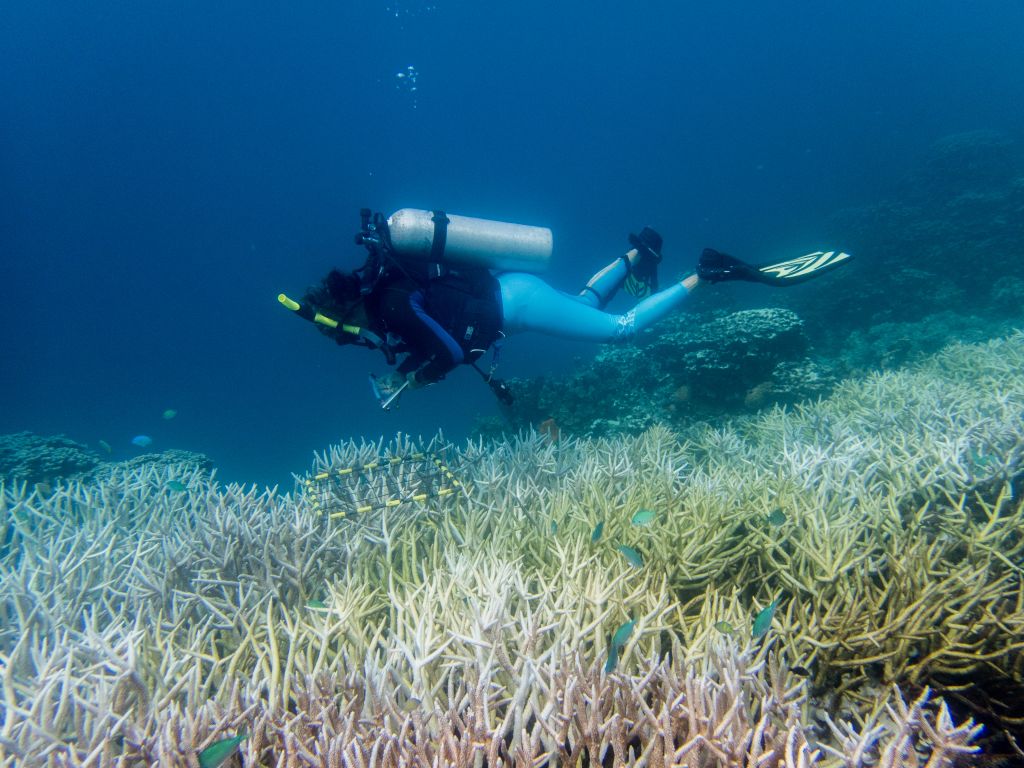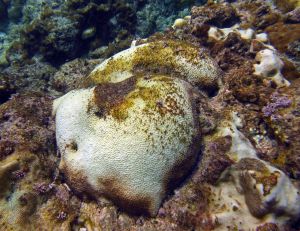Editor’s note: This article is part of the Pacific Islands Climate Adaptation Science Center’s ongoing series to bring awareness to the impacts, damages, and responses to coral bleaching and rising sea temperatures around Pacific Islands.
Pacific Islands brace for global coral bleaching event
July 18, 2024

Coral reefs around the world are age-old providers and defenders of our livelihood. From cultivating food and medicine to protecting our shores from powerful storms, these ecosystems have proven to be vital resources on a global scale. Indigenous Pacific Island communities also find value in coral reefs, and their resources are often integrated into their cultures and traditions.
But a lingering threat to the vitality of these precious ecosystems remains: coral bleaching.
The National Oceanic and Atmospheric Administration (NOAA), which regularly monitors global ocean temperatures, announced earlier this year that the world is experiencing a global bleaching event, with signs of mass bleaching observed in the Pacific, Atlantic, and Indian Oceans since February 2023. With more than a year of impacts, scientists are predicting that conditions will only worsen during the summer months.
This is the fourth recorded global bleaching event, according to NOAA. The last bleaching events, from 2014-2017, were noted as the longest and most damaging bleaching, with approximately 65% of global reef area impacted. NOAA’s Coral Reef Watch is projecting that the current event’s impact will exceed the previous event, with 73% of coral reefs worldwide already impacted by bleaching-level heat stress since the beginning of last year.
In the last series of bleaching events, coral reefs in the Mariana Islands were significantly impacted. A third of Guam’s corals died from rising sea temperatures and over 60% of total coral cover in Saipan, Commonwealth of the Northern Mariana Islands, was lost. On a lighter note, coral reefs in Palau have shown more resilience to thermal stress, while remote islands in the Federated States of Micronesia have seen fewer signs of bleaching than the reefs near the main islands.

Signs of bleaching in Guam
The islands of Micronesia are currently under a bleaching watch this summer. Extreme heat stress conditions for surrounding waters are anticipated through August and September, but corals just off Guam’s coastlines are already exhibiting paling characteristics.
“I can confirm that [corals in Tumon Bay] are bleaching,” said Dr. Laurie Raymundo, director of the University of Guam (UOG) Marine Laboratory and a previous PI-CASC researcher. “I have observed on two separate occasions bleaching in all of the Porites species and in a few colonies of Pocillopora damicornis. Bleaching severity within Porites ranges from slight paling to severe bleaching.”
Other coral species are showing a bit more resilience, Raymundo noted, such as the Pavona and staghorn Acropora. One ongoing research question that Guam coral scientists are looking into is understanding how and why different coral species are more resilient to warming ocean temperatures than others, in addition to variable water qualities and presence of minerals and nutrients.
Raymundo was among local scientists at the forefront of assessing the last series of coral bleaching events from 2013 to 2017. She had reported then that approximately 34% of Guam’s coral reefs died from rising sea temperatures. At the helm of the UOG Marine Laboratory, Raymundo has been managing the propagation and maintenance of coral nurseries to help restore the numbers lost.
“Our coral nurseries remain generally okay, except for a few scattered colonies,” Raymundo said.

The islands of Micronesia are preparing for the worst, however, with eyes on the next few months when sea temperatures are expected to rise even more.
“It’s still very early in the bleaching season, so if things continue to warm, we will likely see very severe bleaching and associated coral mortality within the next couple months,” said David Burdick, a research associate at UOG who coordinates Guam’s Long-term Coral Reef Monitoring Program.
Despite the impacts of bleaching, corals have been on the road to recovery, as noted by Burdick in his recent report, titled “A decade of change on Guam’s coral reefs,” which focused on the overall health and status of coral reefs between 2010 and 2021. The report stated that as of 2021, although total coral cover area was not at the same level as in 2013, before the bleaching events, there have been signs of recovery at some surveyed sites between 2017 and 2021. Seven of those 12 sites saw increases in coral cover ranging from 8% to 72%, while the remaining five sites saw decreases. Understanding the variables for each of these sites will be helpful for reef managers in predicting which areas along Guam’s coasts are being impacted the most by bleaching.
If you see something, say something
Local scientists will continue to monitor the progression of coral bleaching around the islands, but individuals can also do their part to help protect and conserve coral reefs. Avoiding interactions with corals, responsible diving, collecting trash along beaches, and reducing stormwater runoff are just a few individual actions that can help tremendously as a collective.
With early signs of bleaching already detected, there is a greater urgency in looking out for more affected corals. Local scientists are encouraging the public to report any signs of paling corals using the following links:
Check back with PI-CASC for more stories on coral bleaching! Our upcoming pieces will include monitoring strategies for coral bleaching in the Pacific Islands, coral species’ resilience to thermal stress, and more.

